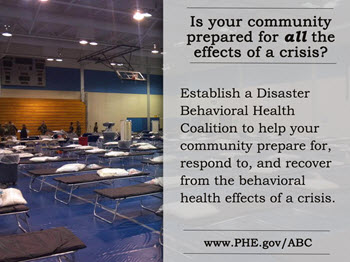Making Your Community More Resilient in the Face of Disasters

Sep 30, 2014
By: Yancy Padilla, Graduate Intern, Division for At-Risk, Behavioral Health & Community Resilience, HHS Office of the Assistant Secretary for Preparedness and Response
When disaster or tragedy strikes, individuals and communities are stressed, they need help fast, and recovery may take a long time. The community’s behavioral health resources – which may have already been strained – are going to be in greater demand than ever and there are often challenges coordinating services. Recent events such as the Washington State Mudslide and the civil unrest in Ferguson Missouri following the fatal shooting of the unarmed young man, Michael Brown, highlighted for local leaders, in both cases, the need for collaboration among community groups and the importance of mobilizing efforts of service providers to come together to address issues related to special populations and to the psychological recovery of all those affected.
So, with this in mind, how can behavioral health planners and providers help their communities get the care they need? Start by working together before a disaster strikes to form a healthcare coalition and make a plan together.
Mental health coalitions work. After the September 11th terrorist attacks, a Mental Health Community Response Coalition was formed that not only provided an avenue for the mental health community to address post-disaster needs, but it also established the foundation for an ongoing coalition of community stakeholders to better prepare for, respond to, and recover from any crisis that may be endured by the Washington, DC metropolitan area in the future.
Healthcare coalitions enhance community resilience by identifying, developing, and leveraging plans and resources necessary for mitigating vulnerabilities; reducing negative health consequences; and helping the community recover more quickly. Establishing a disaster behavioral health coalition can improve communication across provider groups, coordinate behavioral health care efforts, and help identify new and existing needs.
Start by identifying the individuals and organizations that your community already relies on for its behavioral health needs. These could be professional mental health clinicians; other health professionals or paraprofessionals trained in disaster behavioral health interventions; substance abuse treatment providers; and volunteer agencies or faith based groups.
Before a disaster strikes and during an event, work with your coalition to understand what supportive services and treatment options are available, who the providers are, and whether gaps or duplication of services exist. A coalition can help planners and providers identify resources, coordinate communication channels and improve referral processes. Coaliton members can consider decisions regarding their roles and responsibilities as well as their capabilities before a disaster strikes. By forming an effective coalition and examining these issues now, you can promote a more successful response and, ultimately, a more resilient community.
To learn more, check out the HHS disaster behavioral health coalition guidance and additional preparedness resources, which provide guidelines and more indepth considerations for recruiting members, forming a behavioral health coalition and using your coalition to more effectively plan for and recover from disasters and emergencies.
Want to comment on this article? Visit MentalHealth.org on Facebook or on Twitter to post your comments and start a conversation.




